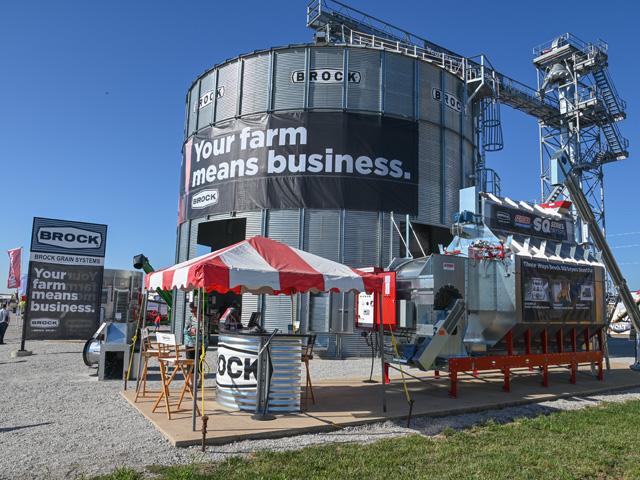Farm Expenses to Rise
Crop Input and Farm Prices Expected to Rise in 2023
BOONE, Iowa (DTN) -- Crop input and other farm costs for 2023 are top of mind for farmers at this week's Farm Progress Show in Boone, Iowa.
The University of Illinois released its first 2023 crop budget estimates earlier this month projecting higher costs and lower returns compared to 2022. Find estimates at https://farmdocdaily.illinois.edu/….
At projected cost levels, per bushel prices of $5.30 per bushel for corn and $12.75 per bushel for soybeans, "marginal profitability" potential -- similar to 2014-2019 -- is expected, according to initial budget estimates.
With soaring inflation, high fuel costs and continued supply chain issues, farm show exhibitors say farmers are keeping a close eye on the bottom line. Farmers are inquiring about pricing for next year on everything from seed and farm chemicals to machinery and supplies, company officials said.
"Oh yeah, they are certainly wondering about costs," said John Tuttle, Brock Grain Systems vice president of sales and marketing.
P[L1] D[0x0] M[300x250] OOP[F] ADUNIT[] T[]
DTN asked officials representing several companies at the show about what farmers can expect pertaining to costs in 2023 compared to this year. (Editor's note: Some responses were edited for clarity and brevity.)
-- Rob Schrick, Bayer strategic business lead: We always look at how much value are you giving the grower (when pricing products) and how much of that value is the grower willing to give back to you in the form of purchase. At the same time, we have to cover our costs, and costs have gone through the roof. I would say you will see moderate price increases coming from Bayer ... for crop protection products. We want to be here for the long haul and that's how we price our products.
-- Daryl Theis, CLAAS head of sales and marketing in North America: As an ag equipment manufacturer, when it comes to prices increases in 2023 compared to 2022, farmers should expect a range of 15% to 25% for tractors, combines and forage harvesters. It could be higher with machinery that has more steel or is more labor intensive to build, such as tillage. There are quite a few factors driving costs up, such as steel, fuel and electricity. Input suppliers we work with have these challenges, too. Labor costs are going up. Inflation is driving up prices. Some of the things we're buying are 10 times higher compared to before COVID-19.
-- Andrea Masella, Trelleborg Wheel Systems country director for North America (maker of Trelleborg and Mitas ag tires): That last few years there were a lot of challenges with supplies, which led to overall cost increases for tires. We don't see this trend slowing down. There's still uncertainty in the market. The good thing is the market is being supported by strong commodity prices. My opinion is costs will stay strong because demand is strong, and the sourcing of materials is challenging. We'll do our best to minimize impact on customers.
-- John Tuttle, Brock Grain Systems vice president of sales and marketing: Right now, it looks like prices have stabilized for grain bins and equipment. We've been on a rollercoaster ride starting in August 2020. A sharp escalation through 2021. Then prices trended down a bit until Russia invaded Ukraine and it shot back up. We've come off those highs and we're in a better place now. Every indication to us from our suppliers is stability from now and into 2023. Steel inventory is better. That's why we think prices will be more stable. We're in a position now to deliver a new bin in five or six weeks. A 50,000- to 100,000-bushel-bin will likely cost in the $2 per bushel range.
-- Marion Calmer, co-owner of Calmer Corn Heads, Inc.: On our corn heads, believe it or not, we were able to stay relatively close (in pricing for 2023 compared to 2022). For us, increase will be more like cost-of-living like 4% to 5%. Steel has been our major input that has gone up in price, and we've been able to absorb some of that. We also sell aftermarket parts. A lot of people are looking at that as a way to keep costs down. I like helping farmers do that.
-- Seth Hill, co-owner of Champion Seed: Costs will go up. There's more expenses going into every bag to produce it, mostly what we're paying farmers for soybeans and corn. Trait providers also need a little bit more for research and development. Ten to 20% increases are what we expect. Trucking has gone up and commodity prices are up. I'll defend corn and soybean seed a little bit because there's a lot of research and development going into it to increase yields.
-- Lisa Bocklage, Morton Buildings marketing manager: Building costs in general are hard to predict. We've seen a lot of volatility over the last few years with input costs of steel and lumber. Fuel costs and labor are another factor. It's hard to predict where prices will be in 2023 based on what we've seen the last couple of years.
-- Ben Hirschfeld, Valley Irrigation territory manager: Until our supply chain issues get resolved, I don't foresee prices going down. I don't see prices (in 2023) increasing compared to the inflated price (hikes) in the last year to 18 months, which were in the 40% range. I would say (2023) price increases will be significantly lower than that.
Matthew Wilde can be reached at matt.wilde@dtn.com
Follow him on Twitter @progressivwilde
(c) Copyright 2022 DTN, LLC. All rights reserved.



